10.2 Basic Concepts
A person’s personality is a relatively stable pattern of thinking, feeling, and behaving that evolves over their lifetime. It is unique to each individual and influenced by their experiences, environment (surroundings and life situations), and inherited characteristics. Personality traits are characteristics, whether considered positive or negative, that make up one’s personality. Healthy personality traits include characteristics such as the following:
- Demonstrating healthy personal boundaries
- Accepting responsibility for personal actions
- Communicating in a healthy and effective manner
- Obeying laws
- Showing mutual respect in relationships
- Being independent
- Displaying confidence
- Behaving in a non-impulsive manner
Review healthy personal boundaries in the “Foundational Mental Health Concepts” chapter. An individual’s personality is considered unhealthy and classified as a disorder when it impacts their interpersonal relationships and results in impaired functioning in social, occupational, or other important areas of their life.[1]
The Diagnostic and Statistical Manual of Mental Disorders (DSM-5-TR) defines a personality disorder as an enduring pattern of inner experience and behavior that deviates significantly from the expectations of the individual’s culture. Its onset can be traced back to adolescence or early adulthood and is present in a variety of contexts. This abnormal pattern of behavior is manifested in two or more of the following areas[2]:
- Cognition (i.e., ways of perceiving and interpreting self, other people, and events)
- Affect (i.e., the range, intensity, lability, and appropriateness of emotional response)
- Interpersonal functioning
- Impulse control
There are ten different personality disorders that are categorized into three clusters (A, B, and C) in the DSM-5-TR. Personality disorders within each cluster have similar patterns of behavior. The ten disorders include Cluster A (paranoid, schizoid, schizotypal), Cluster B (antisocial, narcissistic, borderline, histrionic), and Cluster C (dependent, avoidant, and obsessive-compulsive personality disorder).[3] These disorders are often ego-syntonic, meaning that the behaviors and thoughts are consistent with the individual’s self-perception and are not seen as problematic by the individual, despite causing significant issues in their life.
Each personality disorder is further described in the following sections. As you read through each section, keep in mind that these disorders are more than just personality traits; they are diagnosed based on patterns of behaviors that significantly impair a person’s functioning.
Cluster A Personality Disorders
Cluster A personality disorders include paranoid personality disorder, schizoid personality disorder, and schizotypal personality disorder. Cluster A is characterized as the odd, eccentric cluster. Individuals with these types of disorders often experience social awkwardness.
Paranoid Personality Disorder
The DSM-5-TR defines paranoid personality disorder as a pervasive distrust and suspiciousness of others such that their motives are interpreted as malevolent, beginning in early childhood and present in a variety of contexts. It is diagnosed in individuals with four or more of the following characteristics[4]:
- Suspects without evidence that others are exploiting, harming, or deceiving them
- Preoccupied with unjustified doubts about the loyalty or trustworthiness of friends or associates
- Reluctant to confide in others because of unwarranted fear that the information will be used maliciously against them
- Reads hidden meaning or threatening meanings into benign remarks or events
- Persistently bears grudges (i.e., is unforgiving of insults, injuries, or slights)
- Perceives attacks on their character or reputation that are not apparent to others and is quick to react angrily or to counterattack
- Has recurrent suspicions without justification regarding fidelity of spouse or sexual partner
See Figure 10.1[5] for a word cloud image representing paranoid personality disorder.
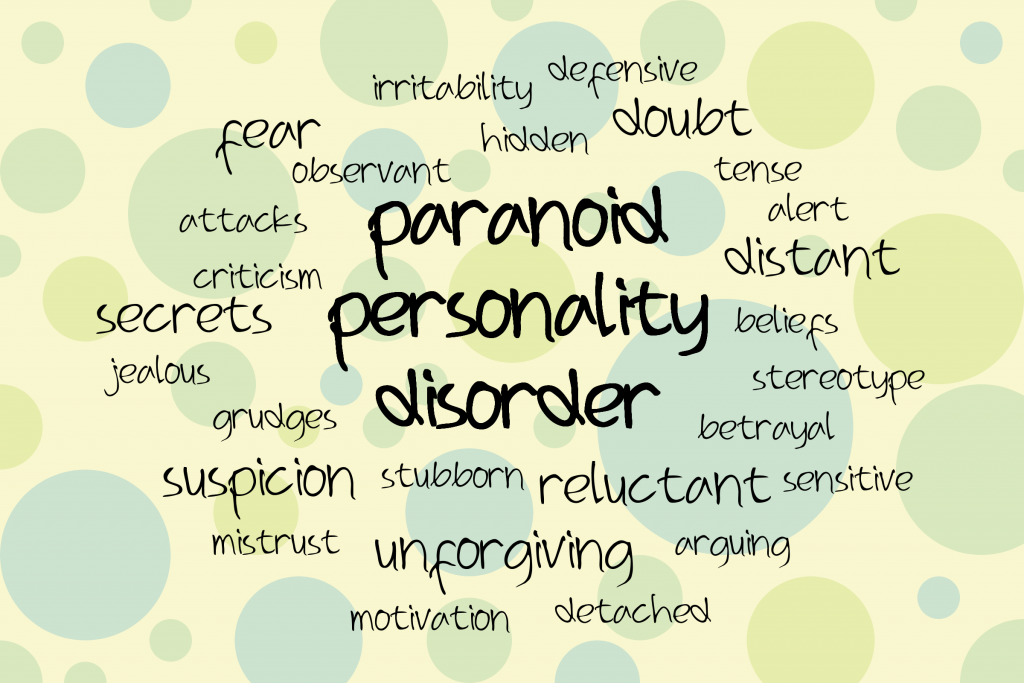
Schizoid Personality Disorder
The DSM-5-TR defines schizoid personality disorder as a pervasive pattern of detachment from social relationships and a restricted range of expression of emotions in interpersonal settings, beginning in early childhood and present in a variety of contexts. It is diagnosed in individuals with four or more of the following characteristics[6]:
- Neither desires nor enjoys close relationships including being part of a family
- Almost always chooses solitary activities
- Has little, if any, interest in having sexual experiences with another person
- Takes pleasure in few, if any, activities
- Lacks close friends other than first-degree relatives
- Appears indifferent to the praise or criticism of others
- Shows emotional coldness, detachment, or flat affect
See Figure 10.2[7] for a word cloud image representing schizoid personality disorder.
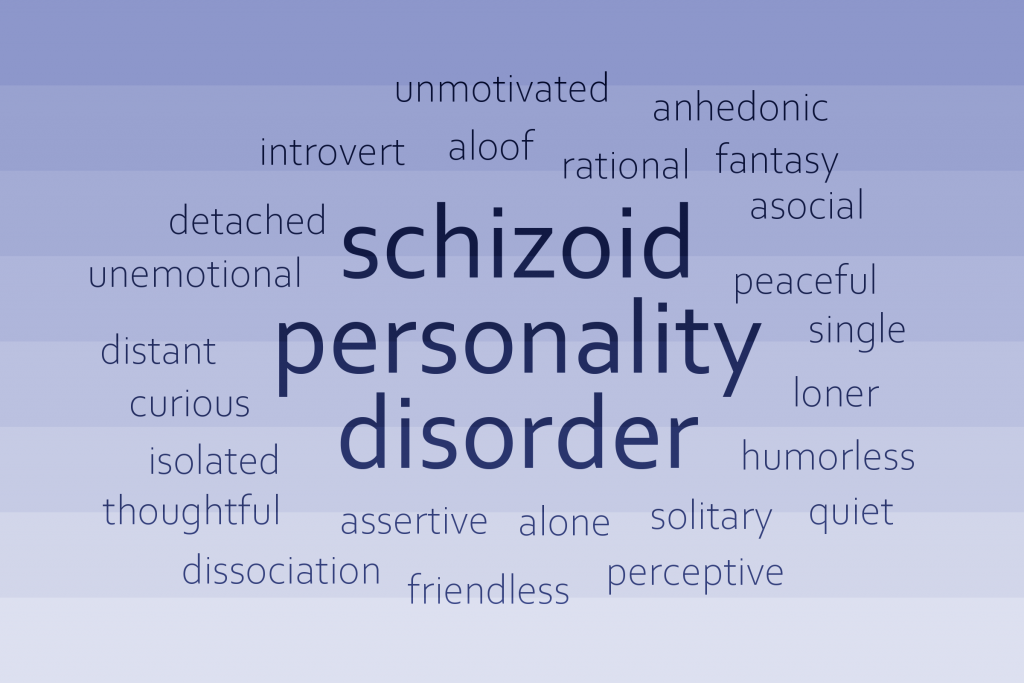
Schizotypal Personality Disorder
The DSM-5 defines schizotypal personality disorder as a pervasive pattern of social and interpersonal deficits marked by acute discomfort with and reduced capacity for close relationships, as well as by cognitive or perceptual distortions and eccentricities of behavior, beginning in early adulthood and present in a variety of contexts. It is diagnosed in individuals with five or more of the following characteristics[8]:
- Ideas of reference (i.e., the false belief that coincidental events relate to oneself). For example, a person shopping in a store sees two strangers laughing and believes that they are laughing at them, when, in reality, the other two people do not even notice them.
- Odd beliefs or magical thinking that influence behavior and are inconsistent with cultural norms (Magical thinking refers to the idea that one can influence the outcome of specific events by doing something that has no bearing on the circumstances. For example, a person watching a baseball game exhibits magical thinking when believing that holding the remote control in a certain position caused their favorite player to hit a home run.)
- Unusual perceptual experiences including bodily illusions (A body illusion refers to a perception that one’s body is significantly different from its actual configuration. For example, a person lying in bed feels as if they are levitating.)
- Odd thinking and speech
- Suspiciousness or paranoid ideation
- Inappropriate or constricted affect
- Behavior or appearance that is odd, eccentric, or peculiar
- Lack of close friends or confidants other than first-degree relatives
- Excessive social anxiety that does not diminish with familiarity and tends to be associated with paranoid fears rather than negative judgments about self
Please Note: There are key differences between the schizotypal and schizoid. Schizoid is marked by social detachment and emotional coldness without cognitive or perceptual distortions, whereas schizotypal includes these social deficits along with cognitive or perceptual distortions and eccentric behavior.
See Figure 10.3[9] for a word cloud image representing schizotypal personality disorder.
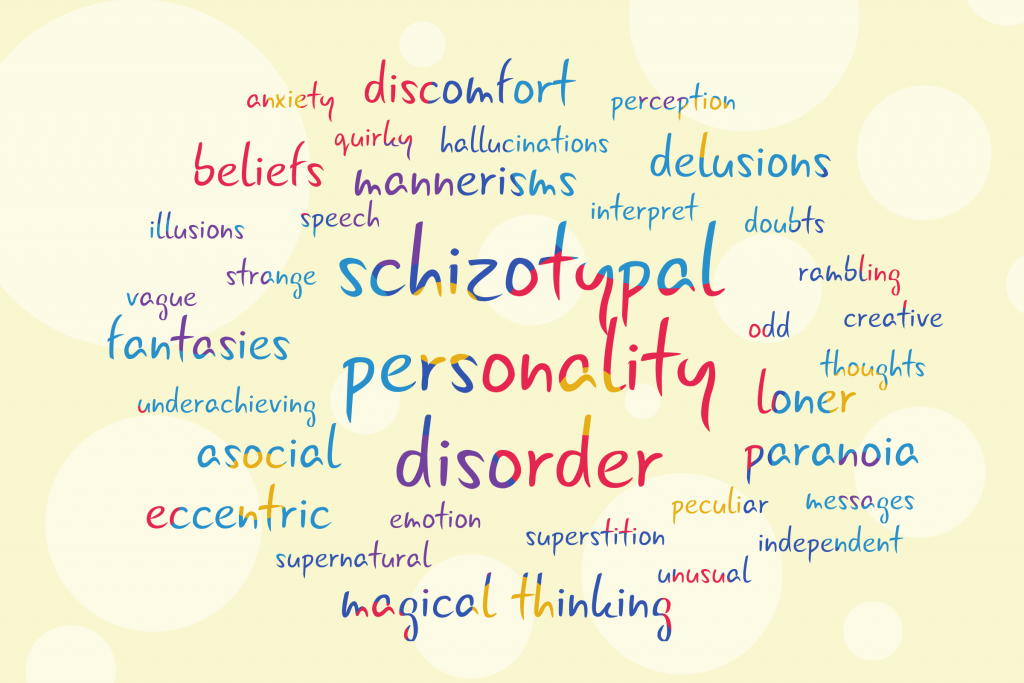
Cluster B Personality Disorders
Cluster B personality disorders include antisocial, borderline, histrionic, and narcissistic personality disorders. Cluster B personality disorders are characterized by dramatic, overly emotional, or unpredictable thinking or behavior.
Antisocial Personality Disorder
The DSM-5-TR defines antisocial personality disorder as a pervasive pattern of disregard for and violation of the rights of others since age 15. It is diagnosed in individuals with three or more of the following characteristics[10]]:
- Failure to conform to social norms with respect to lawful behaviors, as indicated by repeatedly performing acts that are grounds for arrest
- Deceitfulness, as indicated by repeated lying, use of aliases, or conning others for personal profit or pleasure
- Impulsivity or failure to plan ahead
- Irritability and aggressiveness, as indicated by repeated physical fights and assaults
- Reckless disregard for the safety of self or others
- Consistent irresponsibility, as indicated by repeated failure to sustain consistent work behavior or honor financial obligations
- Lack of remorse, as indicated by being indifferent to or rationalizing having hurt, mistreated, or stolen from another person
See Figure 10.4[11] for a word cloud image representing antisocial personality disorder.
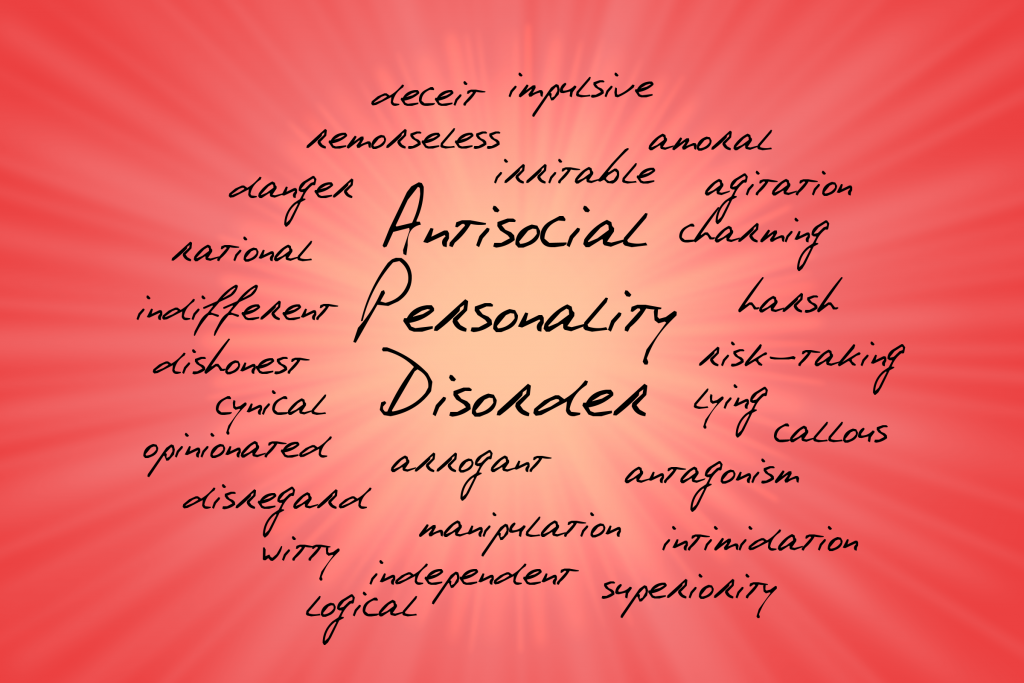
Borderline Personality Disorder
The DSM-5-TR defines borderline personality disorder as a pervasive pattern of instability of personal relationships, self-image, and affect with significant impulsivity, beginning in early adulthood and present in a variety of contexts. It is diagnosed in individuals with five or more of the following characteristics[12]:
- Frantic efforts to avoid real or imagined abandonment
- A pattern of unstable and intense personal relationships characterized by alternating between extremes of idealization and devaluation (referred to as splitting)
- Identity disturbance with significantly and persistently unstable self-image or sense of self
- Impulsivity in at least two areas that are potentially self-damaging (e.g., spending, sex, substance misuse, reckless driving, or binge eating)
- Recurrent suicidal behavior or self-mutilating behavior
- Unstable affect with significant mood reactivity (i.e., intense anxiety or irritability usually lasting only a few hours)
- Chronic feelings of emptiness
- Inappropriate, intense anger or difficulty controlling anger
- Transient, stress-related paranoid ideation or severe dissociative symptoms (Dissociative symptoms include the experience of detachment or feeling as if one is outside one’s body. It is often associated with loss of memory of the experience. Dissociative disorders are associated with an individual’s previous experience of trauma.)
See Figure 10.5[13] for a word cloud image representing borderline personality disorder.
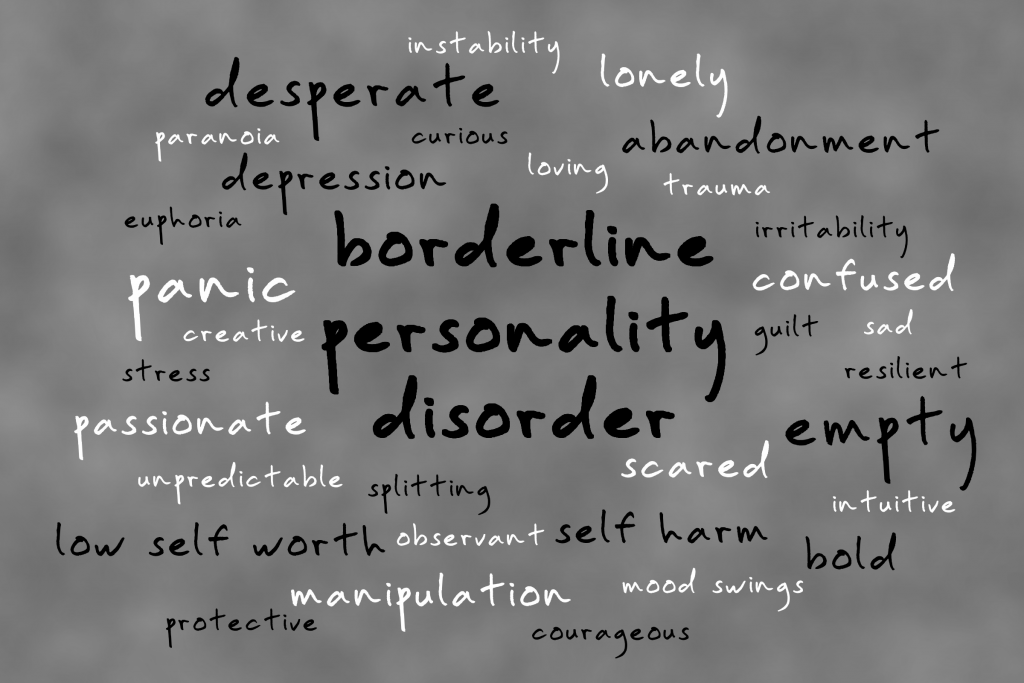
Histrionic Personality Disorder
The DSM-5-TR defines histrionic personality disorder as a pervasive pattern of excessive emotionality and attention seeking, beginning in early adulthood and present in a variety of contexts. It is diagnosed in individuals with five or more of the following characteristics[14]:
- Uncomfortable in situations in which they are not the center of attention
- Interaction with others is characterized by inappropriate sexually seductive or provocative behavior
- Rapidly shifting and shallow expression of emotion
- Consistently uses physical appearance to draw attention to oneself
- Excessively impressionistic speech that is lacking in detail
- Shows self-dramatization, theatricality, and exaggerated expression of emotion
- Suggestible (i.e., easily influenced by others)
- Considers relationships to be more intimate than they actually are
See Figure 10.6[15] for a word cloud image representing histrionic personality disorder.
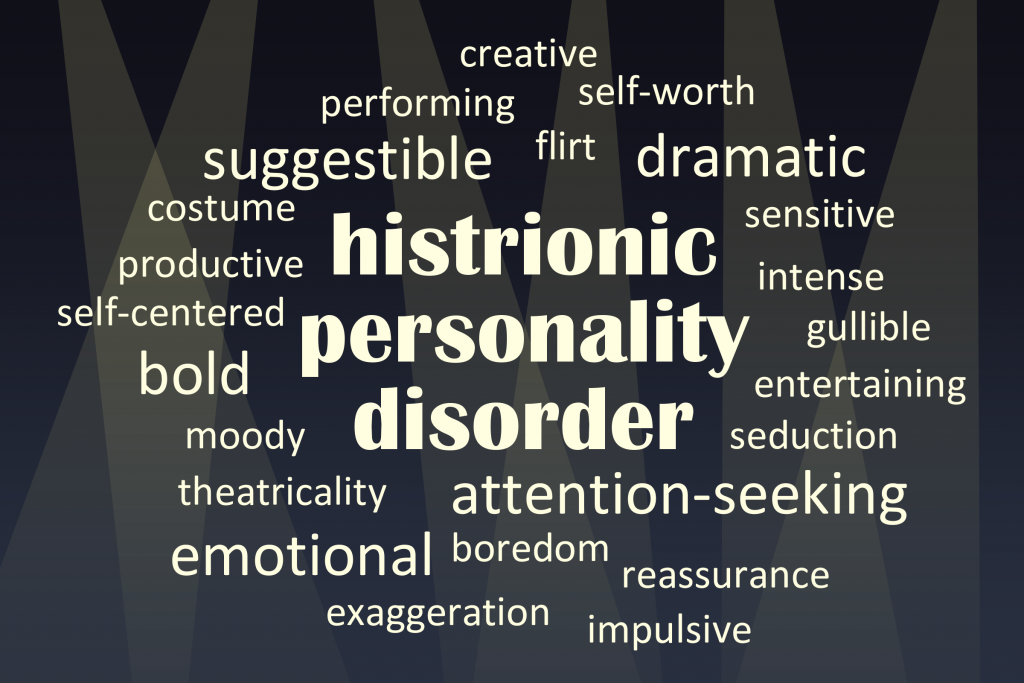
Narcissistic Personality Disorder
The DSM-5-TR defines narcissistic personality disorder as a pervasive pattern of grandiosity (in fantasy or behavior), need for attention, and lack of empathy, beginning in early adulthood and present in a variety of contexts. It is diagnosed in individuals with five or more of the following characteristics[16]:
- Has a grandiose sense of self-importance (i.e., exaggerates achievements and talents)
- Is preoccupied with fantasies of unlimited success, power, brilliance, beauty, or ideal love
- Believes they are “special” and can only be understood by, or should only associate with, other “special” or high-status people (or institutions)
- Requires excessive admiration
- Has a sense of entitlement (i.e., unreasonable expectations of especially favorable treatment)
- Exploits others to achieve their own goals
- Lacks empathy and the ability to identify with the feelings and needs of others
- Is often envious of others or believes that others are envious of them
- Shows arrogant or haughty behaviors or attitudes
See Figure 10.7[17] for a word cloud image representing narcissistic personality disorder.
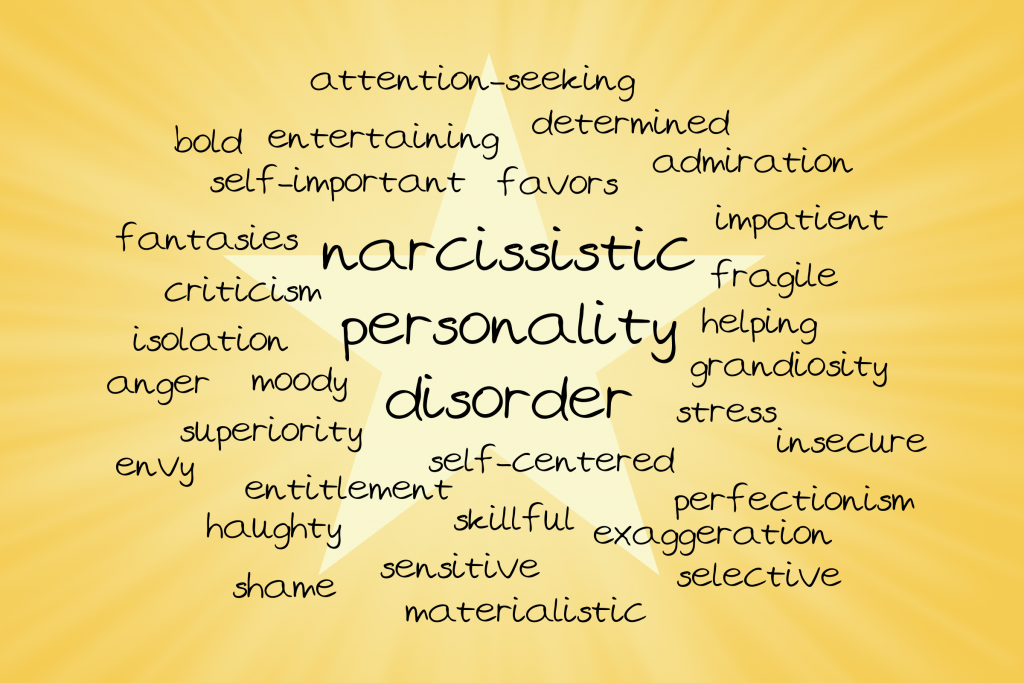
Cluster C Personality Disorders
Cluster C personality disorders include avoidant, dependent, and obsessive-compulsive personality disorders. Cluster C personality disorders are characterized by anxious, fearful thinking or behavior.
Avoidant Personality Disorder
The DSM-5-TR defines avoidant personality disorder as a pervasive pattern of social inhibition, feelings of inadequacy, and hypersensitivity to negative evaluation, beginning in early adulthood and present in a variety of contexts. It is diagnosed in individuals with four or more of the following characteristics[18]:
- Avoids occupational activities that involve significant interpersonal contact because of fears or criticism, disapproval, or rejection
- Is unwilling to get involved with people unless certain of being liked
- Shows restraint within intimate relationships because of the fear of being shamed or ridiculed
- Is preoccupied with being criticized or rejected in social situations
- Is inhibited in new interpersonal situations because of feelings of inadequacy
- Views self as socially inept, personally unappealing, or inferior to others
- Is unusually reluctant to take personal risks or to engage in any new activities because they may prove embarrassing
See Figure 10.8[19] for a word cloud image representing avoidant personality disorders.
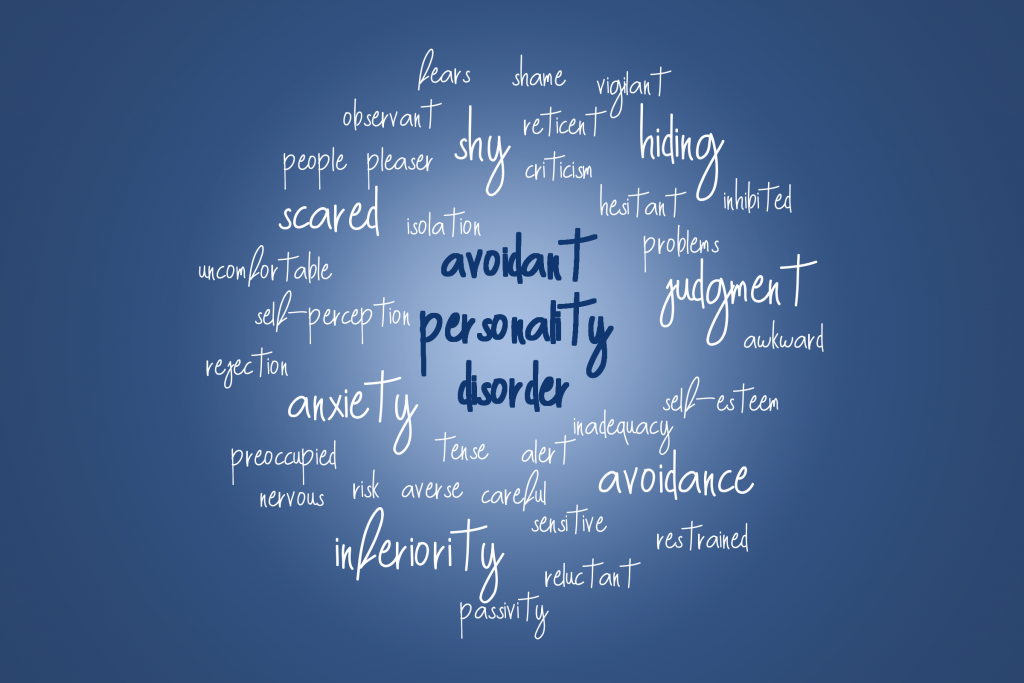
Dependent Personality Disorder
The DSM-5-TR defines dependent personality disorder as a pervasive and excessive need to be taken care of that leads to submission and clinging behavior and fears of separation, beginning in early childhood and present in a variety of contexts. It is diagnosed by five or more of the following characteristics[20]:
- Has difficulty making everyday decisions without an excessive amount of advice and reassurance from others
- Needs others to assume responsibility for most major areas of their life
- Has difficulty expressing disagreement with others because of fear of loss or support or approval
- Has difficulty initiating projects or doing things on their own because of lack of self-confidence in judgment or abilities
- Goes to excessive lengths to obtain nurturance and support from others to the point of volunteering to do things that are unpleasant
- Feels uncomfortable or helpless when alone because of exaggerated fears of being unable to care for themselves
- Urgently seeks another relationship as a source of care and support when a close relationship ends
- Is unrealistically preoccupied with fears of being left to take care of themselves
See Figure 10.9[21] for a word cloud image representing dependent personality disorder.
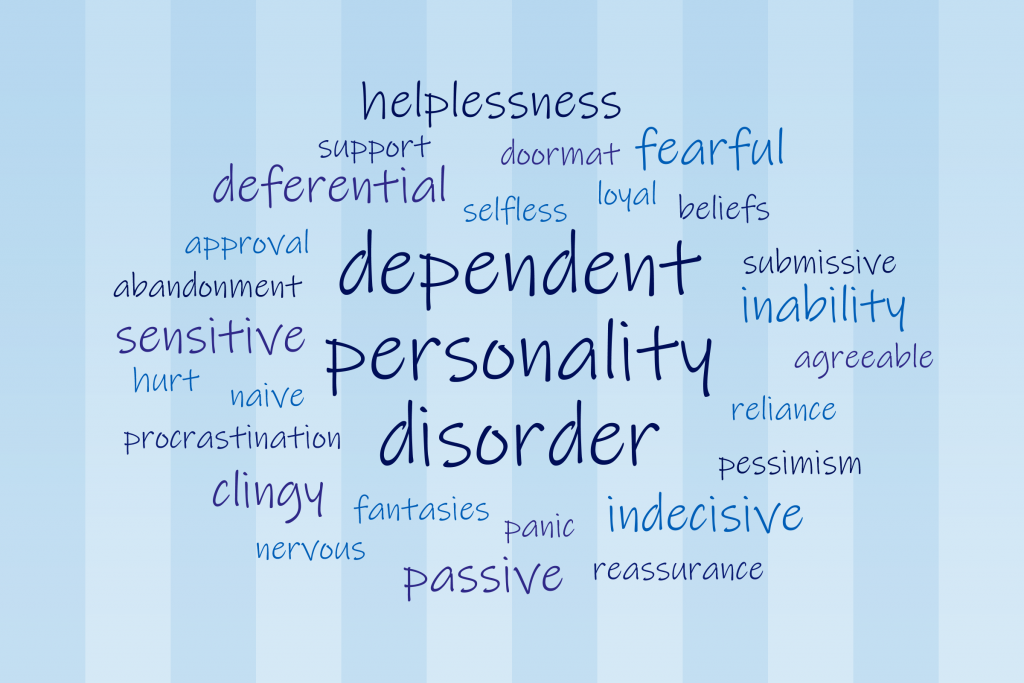
Obsessive-Compulsive Personality Disorder
The DSM-5-TR defines obsessive-compulsive personality disorder as a pervasive pattern or preoccupation with orderliness, perfectionism, and mental and interpersonal control at the expense of flexibility, openness, and efficiency, beginning in early childhood and present in a variety of contexts. It is diagnosed in individuals with four or more of the following characteristics[22]:
- Is preoccupied with details, rules, lists, order, organization, or schedules to the extent that the major point of the activity is lost
- Shows perfectionism that interferes with task completion (i.e., is unable to complete a project because their overly strict standards are not met)
- Is excessively devoted to work and productivity to the exclusion of leisurely activities and friendships
- Is overconscientious, scrupulous, and inflexible about matters of morality, ethics, or values (not accounted for by cultural or religious identification)
- Is unable to discard worn-out or worthless objects even when they have no sentimental value
- Is reluctant to delegate tasks or work with others unless they submit to exactly their way of doing things
- Adopts a miserly spending style towards self and others; money is viewed as something to be hoarded for future catastrophes
- Shows rigidity and stubbornness
It is important to note that obsessive-compulsive personality disorder (OCPD) is a different disorder than obsessive-compulsive disorder (OCD). OCPD includes long-term personality traits characterized by extreme perfectionism, rigidity, and adherence to rules. A person with OCPD is often proud of these personality traits. Conversely, OCD includes uncontrollable, recurring thoughts (obsessions) and/or behaviors (compulsions) that cause the individual significant emotional distress.
Review the “Obsessive-Compulsive Disorder” section of the “Anxiety Disorders” chapter for more details about obsessive-compulsive disorder.
See Figure 10.10[23] for a word cloud image representing obsessive-compulsive personality disorder.
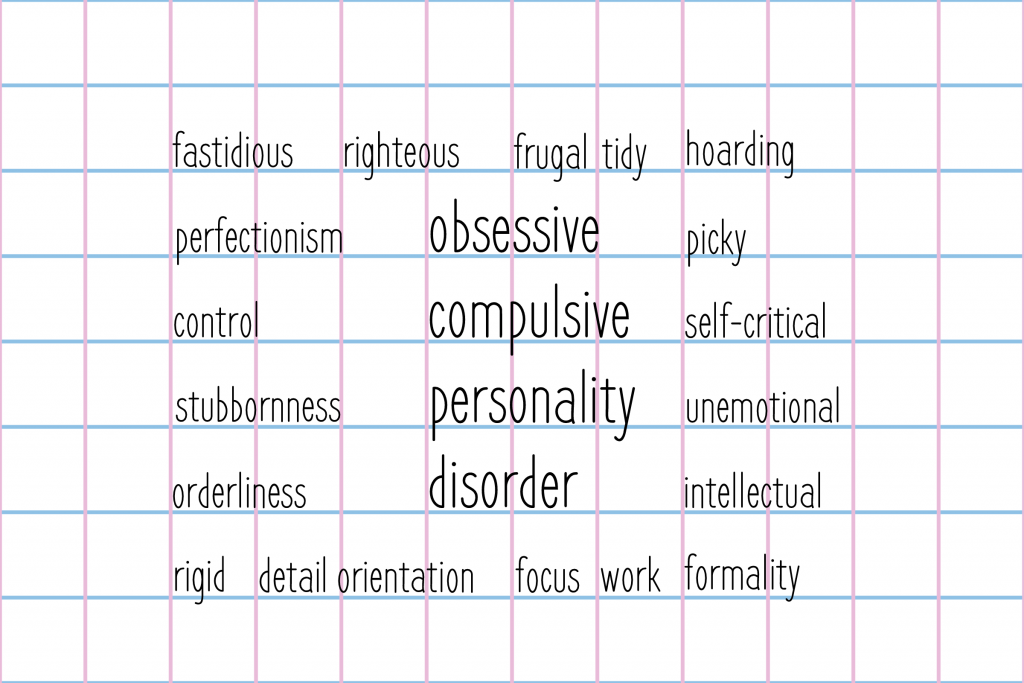
View the following Khan Academy YouTube video explaining personality disorders[24]: Personality Disorders.
Reflective Question:
- When does one’s personality become a disorder versus just personality traits?
Risk Factors for Personality Disorders
Research suggests that genetics, childhood trauma, peer influences, and other factors can contribute to the development of personality disorders.[25];[26]
- Adverse Childhood Experiences (ACEs): Multiple studies have shown that childhood adversities such as emotional, physical, and sexual abuse, as well as neglect, significantly increase the risk of developing personality disorders. For instance, childhood emotional abuse and neglect have been strongly associated with borderline personality disorder (BPD).[27]
- Perinatal Complications: Factors such as prematurity, asphyxia, and complicated deliveries have been linked to an increased risk of personality disorders. These perinatal complications may lead to abnormal brain development, which can predispose individuals to personality pathology.[28]
- Prenatal Stress: Exposure to maternal stress during pregnancy has been associated with a higher likelihood of developing personality disorders in offspring. This association remains significant even after adjusting for other factors such as parental psychiatric history and prenatal smoking.[29]
- Childhood Behavioral Problems: Early conduct problems, depressive symptoms, anxiety, and immaturity have been identified as predictors of personality disorders in adolescence and adulthood. Conduct problems, in particular, have been shown to be an independent predictor across all clusters of personality disorders.[30]
- Genetic and Temperamental Factors: Certain temperamental traits, such as high neuroticism and low agreeableness, have been implicated in the development of personality disorders. These traits can interact with environmental factors to increase the risk.[31],[32]
- Invalidating Relational Experiences: Maladaptive parenting, problematic peer relationships, and other invalidating experiences during childhood and adolescence can contribute to the development of personality disorders, particularly.[33]
Certain positive factors can help prevent children from developing personality disorders. For example, a single strong relationship with a relative, teacher, or friend can offset negative influences. Strong resiliency factors contribute to the health and development of a child.[34]
- American Psychiatric Association. (2013). Desk reference to the diagnostic criteria from DSM-5. ↵
- American Psychiatric Association. (2022). Desk reference to the diagnostic criteria from DSM-5-TR (5th ed.). American Psychiatric Association Publishing. ↵
- American Psychiatric Association. (2022). Desk reference to the diagnostic criteria from DSM-5-TR (5th ed.). American Psychiatric Association Publishing. ↵
- American Psychiatric Association. (2013). Desk reference to the diagnostic criteria from DSM-5. ↵
- “Word_Cloud_PPD.png” by MissLunaRose12 is licensed under CC BY-SA 4.0 ↵
- American Psychiatric Association. (2022). Desk reference to the diagnostic criteria from DSM-5-TR (5th ed.). American Psychiatric Association Publishing. ↵
- “Word_Cloud_SzPD.png” by MissLunaRose12 is licensed under CC BY-SA 4.0 ↵
- American Psychiatric Association. (2022). Desk reference to the diagnostic criteria from DSM-5-TR (5th ed.). American Psychiatric Association Publishing. ↵
- “Word_Cloud_StPD.png” by MissLunaRose12 is licensed under CC BY-SA 4.0 ↵
- American Psychiatric Association. (2022). Desk reference to the diagnostic criteria from DSM-5-TR (5th ed.). American Psychiatric Association Publishing. ↵
- “Word_Cloud_AsPD.png” by MissLunaRose12 is licensed under CC BY-SA 4.0 ↵
- American Psychiatric Association. (2022). Desk reference to the diagnostic criteria from DSM-5-TR (5th ed.). American Psychiatric Association Publishing. ↵
- “Word_Cloud_BPD.png” by MissLunRose12 is licensed under CC BY-SA 4.0 ↵
- American Psychiatric Association. (2022). Desk reference to the diagnostic criteria from DSM-5-TR (5th ed.). American Psychiatric Association Publishing. ↵
- “Word_Cloud_HPD.png” by MissLunRose12 is licensed under CC BY-SA 4.0 ↵
- American Psychiatric Association. (2022). Desk reference to the diagnostic criteria from DSM-5-TR (5th ed.). American Psychiatric Association Publishing. ↵
- “Word_Cloud_NPD.png” by MissLunRose12 is licensed under CC BY-SA 4.0 ↵
- American Psychiatric Association. (2022). Desk reference to the diagnostic criteria from DSM-5-TR (5th ed.). American Psychiatric Association Publishing. ↵
- “Word_Cloud_AvPD.png” by MissLunRose12 is licensed under CC BY-SA 4.0 ↵
- American Psychiatric Association. (2022). Desk reference to the diagnostic criteria from DSM-5-TR (5th ed.). American Psychiatric Association Publishing. ↵
- “Word_Cloud_DPD.png” by MissLunRose12 is licensed under CC BY-SA 4.0 ↵
- American Psychiatric Association. (2022). Desk reference to the diagnostic criteria from DSM-5-TR (5th ed.). American Psychiatric Association Publishing. ↵
- “Word_Cloud_OCPD.png” by MissLunRose12 is licensed under CC BY-SA 4.0 ↵
- khanacademymedicine. (2015, July 20). Personality disorders | Behavior | MCAT | Khan Academy [Video]. YouTube. All rights reserved. https://youtu.be/-Xv593jgyJ4 ↵
- American Psychological Association (2010). What causes personality disorders? https://www.apa.org/topics/personality-disorders/causes ↵
- Solmi, M., Dragioti, E., Croatto,G., Radua, J., Borgwardt, S., Carvalho, A. F., Demurtas, J., Mosina, A., Kurotschka, P., Thompson, T., Cortese, S., Shin, J. I., & Fusar-Poli, P. (2021). Risk and protective factors for personality disorders: An umbrella review of published meta-analyses of case-control and cohort studies. Front Psychiatry, 12, 679379. doi: 10.3389/fpsyt.2021.679379. ↵
- Broekhof, R., Nordahl, H. M., Eikenæs, I. U., & Selvik, S. G. (2024). Adverse childhood experiences are associated with personality disorder: A prospective, longitudinal study. Journal of Personality Disorders, 38(1), 19-33. doi: 10.1521/pedi.2024.38.1.19. ↵
- Fazel, S., Bakiyeva, L., Cnattingius, S., Grann, M., Hultman, C. M., Lichtenstein, P., & Geddes, J. R. (2012). Perinatal risk factors in offenders with severe personality disorder: A population-based investigation. Journal of Personality Disorders, 26(5), 737-50. doi: 10.1521/pedi.2012.26.5.737. ↵
- Brannigan, R., Tanskanen, A., Huttunen, M. O., Cannon, M., Leacy, F. P., & Clarke, M. C. (2020). The role of prenatal stress as a pathway to personality disorder: Longitudinal birth cohort study. The British Journal of Psychiatry, 216(2), 85-89. doi: 10.1192/bjp.2019.190. ↵
- Bernstein, D. P., Cohen, P., Skodol, A., Bezirganian, S., & Brook, J. S. (1996). Childhood antecedents of adolescent personality disorders. American Journal of Psychiatry, 153(7), 907-13. doi: 10.1176/ajp.153.7.907. ↵
- American Psychological Association (2010). What causes personality disorders? https://www.apa.org/topics/personality-disorders/causes ↵
- Junewicz, A., & Billick, S. B. (2021). Preempting the development of antisocial behavior and psychopathic traits, The Journal of American Academy of Psychiatry Law, 49(1), 66-76. https://doi10.29158/JAAPL.200060-20 ↵
- Solmi, M., Dragioti, E., Croatto ,G., Radua, J., Borgwardt, S., Carvalho, A.F., Demurtas, J., Mosina, A., Kurotschka, P., Thompson, T., Cortese, S., Shin, J. I., & Fusar-Poli, P. (2021). Risk and protective factors for personality disorders: An umbrella review of published meta-analyses of case-control and cohort studies. Front Psychiatry, 12, 679379. doi: 10.3389/fpsyt.2021.679379. ↵
- American Psychological Association (2010). What causes personality disorders? https://www.apa.org/topics/personality-disorders/causes ↵
A relatively stable pattern of thinking, feeling, and behaving that evolves over a person’s lifetime and is unique to each individual.
Characteristics, whether considered good or bad, that make up one’s personality.
An enduring pattern of inner experience and behavior that deviates significantly from the expectations of one’s culture.
Behaviors and thoughts are consistent with the individual's self-perception and are not seen as problematic by the individual, despite causing significant issues in their life.
Include paranoid personality disorder, schizoid personality disorder, and schizotypal personality disorder; characterized by odd, eccentric, and socially awkward behavior.
A pervasive distrust and suspiciousness of others such that their motives are interpreted as malevolent.
A pervasive pattern of detachment from social relationships and a restricted range of expression of emotions in interpersonal settings.
A pervasive pattern of social and interpersonal deficits marked by acute discomfort with and reduced capacity for close relationships, as well as by cognitive or perceptual distortions and eccentricities of behavior.
False beliefs that coincidental events relate to oneself.
The idea that one can influence the outcome of specific events by doing something that has no bearing on the circumstances.
A perception that one's own body is significantly different from its actual configuration.
Antisocial, borderline, histrionic, and narcissistic personality disorders; characterized by dramatic, overly emotional, or unpredictable thinking or behavior.
A pervasive pattern of disregard for and violation of the rights of others since age 15.
A pervasive pattern of instability of personal relationships, self-image, and affect with significant impulsivity.
A pattern of unstable and intense personal relationships characterized by alternating between extremes of idealization and devaluation.
The experience of detachment or feeling as if one is outside one's body with loss of memory.
A pervasive pattern of excessive emotionality and attention seeking.
A pervasive pattern of grandiosity (in fantasy or behavior), need for attention, and lack of empathy.
Unreasonable expectations of especially favorable treatment.
Avoidant, dependent, and obsessive-compulsive personality disorders; characterized by anxious, fearful thinking or behavior.
A pervasive pattern of social inhibition, feelings of inadequacy, and hypersensitivity to negative evaluation.
A pervasive and excessive need to be taken care of that leads to submission and clinging behavior and fears of separation.
A pervasive pattern or preoccupation with orderliness, perfectionism, and mental and interpersonal control at the expense of flexibility, openness, and efficiency.

